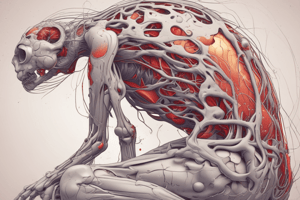Podcast
Questions and Answers
Serous inflammation is characterized by fluid derived from which sources?
Serous inflammation is characterized by fluid derived from which sources?
- Lymphatic drainage and blood transudate
- Adipose tissue and plasma
- Blood exudate and mesothelial cell secretions (correct)
- Epithelial cell secretions and transudate
Which characteristic feature distinguishes fibrinous inflammation from other types of inflammation?
Which characteristic feature distinguishes fibrinous inflammation from other types of inflammation?
- An exudate rich in eosinophils
- An exudate rich in neutrophils
- An exudate rich in plasma cells
- An exudate rich in fibrin (correct)
In serofibrinous inflammation, what condition would the visceral and parietal layers exhibit?
In serofibrinous inflammation, what condition would the visceral and parietal layers exhibit?
- Smooth and highly vascularized
- Thickened, reticulated, opaque, and gray (correct)
- Thin and transparent
- Atrophied and dry
What microscopic feature is characteristic of serofibrinous inflammation?
What microscopic feature is characteristic of serofibrinous inflammation?
What primary feature characterizes catarrhal inflammation?
What primary feature characterizes catarrhal inflammation?
Which description accurately portrays the microscopic appearance of mucosa in catarrhal inflammation?
Which description accurately portrays the microscopic appearance of mucosa in catarrhal inflammation?
What is the cause of pseudomembranous inflammation?
What is the cause of pseudomembranous inflammation?
What components contribute to the formation of the false membrane in pseudomembranous inflammation?
What components contribute to the formation of the false membrane in pseudomembranous inflammation?
What is a key feature of acute haemorrhagic inflammation?
What is a key feature of acute haemorrhagic inflammation?
Which process characterizes necrotizing inflammation?
Which process characterizes necrotizing inflammation?
What microscopic changes would you expect to see in the subserosa during serofibrinous inflammation?
What microscopic changes would you expect to see in the subserosa during serofibrinous inflammation?
Which of the following is an event that triggers the pathogenesis of pseudomembranous inflammation in mucous membranes?
Which of the following is an event that triggers the pathogenesis of pseudomembranous inflammation in mucous membranes?
In allergic inflammation, what type of immune cell is typically abundant?
In allergic inflammation, what type of immune cell is typically abundant?
Which feature specifically characterizes serous inflammation?
Which feature specifically characterizes serous inflammation?
What change is most likely to occur in epithelial cells of the mucosa during catarrhal inflammation?
What change is most likely to occur in epithelial cells of the mucosa during catarrhal inflammation?
In adults, which condition is an example of fibrinous inflammation?
In adults, which condition is an example of fibrinous inflammation?
Consider a patient with skin blisters after a sunburn versus vesicles appearing due to a herpes simplex infection. Which type of inflammation is primarily involved in both scenarios?
Consider a patient with skin blisters after a sunburn versus vesicles appearing due to a herpes simplex infection. Which type of inflammation is primarily involved in both scenarios?
If you examined a tissue sample from pseudomembranous inflammation under a microscope, what cellular components would you expect to observe?
If you examined a tissue sample from pseudomembranous inflammation under a microscope, what cellular components would you expect to observe?
If a patient's serous membranes have inflammation, and they show an abundance of serous fluid – effusion – without signs of extensive fibrin deposition under examination, which kind of inflammation would be suspected?
If a patient's serous membranes have inflammation, and they show an abundance of serous fluid – effusion – without signs of extensive fibrin deposition under examination, which kind of inflammation would be suspected?
Bronchial asthma, urticaria, and allergic rhinitis share which common type of underlying inflammation?
Bronchial asthma, urticaria, and allergic rhinitis share which common type of underlying inflammation?
Flashcards
Serous Inflammation
Serous Inflammation
Characterized by exudate rich in serous fluid with little fibrin; fluid from blood or mesothelial cells.
Fibrinous Inflammation
Fibrinous Inflammation
Inflammation characterized by an exudate rich in fibrin; less fluid component
Serofibrinous Inflammation
Serofibrinous Inflammation
Inflammation of serous membranes that can be of serous or fibrinous.
Catarrhal Inflammation
Catarrhal Inflammation
Signup and view all the flashcards
Pseudomembranous Inflammation
Pseudomembranous Inflammation
Signup and view all the flashcards
Hemorrhagic Inflammation
Hemorrhagic Inflammation
Signup and view all the flashcards
Necrotizing Inflammation
Necrotizing Inflammation
Signup and view all the flashcards
Allergic Inflammation
Allergic Inflammation
Signup and view all the flashcards
Study Notes
- Acute Nonsuppurative Inflammation encompasses various types of inflammation without pus formation.
Serous Inflammation
- Characterized by excessive serous fluid low in fibrin.
- The serous fluid in serous inflammation comes from blood exudate or the secretions of mesothelial cells.
- Seen in inflammation of serous membranes.
- Examples of serous inflammation can include skin blisters resulting from skin burns.
- Epidermal vesicles from herpes simplex viral infections are examples of serous inflammation.
- Inflammation of serous membranes like the pleura, pericardium, and peritoneum are further examples.
Fibrinous Inflammation
- Distinguished by an exudate rich in fibrin with minimal fluid.
- Lobar pneumonia exemplifies this, where excessive fibrin aids in the consolidation of affected lung areas.
- Adult hyaline membrane disease and inflammation of serous membranes also exemplify the condition.
Serofibrinous Inflammation
- Inflammation of serous membranes may manifest as the serous type or fibrinous type.
- Serous type is sometimes referred to as "wet", while fibrinous type, may be called "dry".
- Serous membranes can be affected by suppurative inflammation and other types beyond the fibrinous and serous types.
- In fibrinous type, the visceral and parietal layers of serous membranes thicken and become reticulated, opaque, and greyish.
- In serous type, the serous sac contains plentiful serous fluid.
- Microscopically, the subserosa has dilated capillaries, fibrin, and acute inflammatory cells.
- Fibrinous inflammation shows the serosal layer coated in a dense fibrin network entangling acute inflammatory cells.
Catarrhal Inflammation
- Catarrhal Inflammation: A mild form of acute inflammation of mucus membranes with exudate mixed with secreted mucus.
- Common cold and catarrhal appendicitis can be examples.
- Grossly, the mucosa will be swollen and hyperemic, discharging a serous fluid mixed with mucus.
- Microscopically, mucosal epithelial cells swell and vacuolate from excess mucin, with submucosal dilated capillaries, PMNs, macrophages, and fibrin.
Pseudomembranous (Membranous) Inflammation
- A severe form of acute inflammation occurs in mucous membranes and is caused by bacteria-producing exotoxins.
- This leads to mucosal necrosis and marked submucosal inflammation.
- This inflammation results in a false membrane that contains necrotic mucosal patches and excessive fibrin.
- Examples of Pseudomembranous Inflammation include diphtheria and bacillary dysentery.
- Grossly, the original mucous membrane is replaced with a yellowish-gray, thick, adherent, "false" membrane.
- If removed forcibly, it leaves a bleeding surface that reforms quickly.
- Microscopically, the false membrane includes necrotic patches, fibrin, bacteria, and acute inflammatory cells.
- The underlying submucosa possesses dilated capillaries, fibrin, and acute inflammatory cells, including PMNs and macrophages.
Other Types of Acute Non Suppurative Inflammation
- Haemorrhagic Inflammation: Characterized by excessive erythrocytes in the exudate due to related vascular damage.
- Smallpox can be an example of haemorrhagic inflammation.
- Necrotizing Inflammation: Defined by extensive necrosis associated with inflammation.
- Cancrum oris can be an example of necrotizing inflammation.
- Allergic Inflammation: Originates from hypersensitivity, typically involving numerous eosinophils.
- Examples include urticaria, allergic rhinitis, and bronchial asthma.
Studying That Suits You
Use AI to generate personalized quizzes and flashcards to suit your learning preferences.




